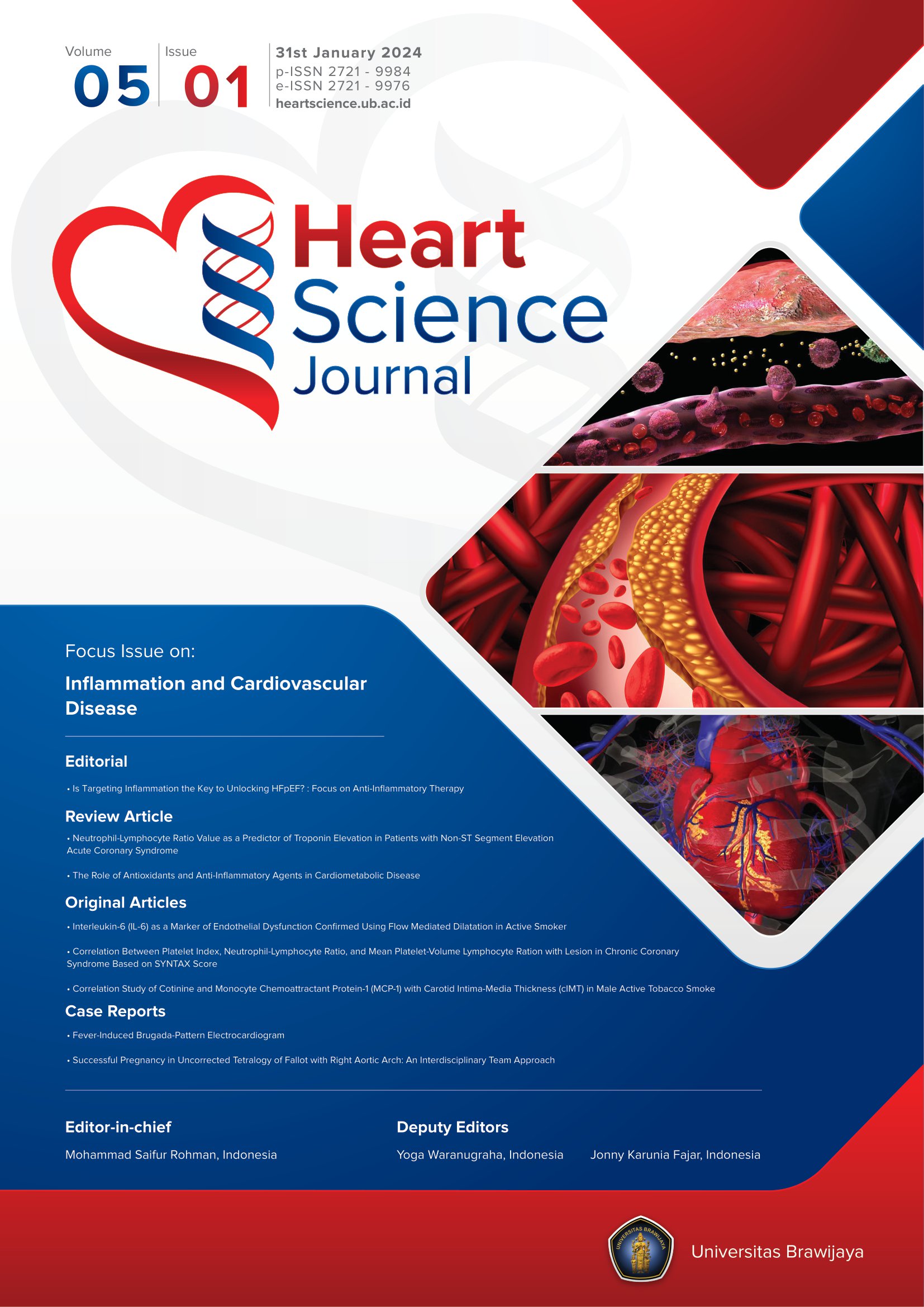Do Myocardial Blush Grade Following Chronic Total Occlusion Recanalization Improve Clinical Outcome of Chronic Coronary Syndromes Patients?
Abstract
Background : Myocardial blush grade (MBG) is an angiographic parameter to describe the adequacy of myocardial reperfusion. The correlation between myocardial blush and the clinical outcome following chronic total occlusion (CTO) recanalization is still unclear. Our study aimed to investigate the impact of myocardial blush after CTO recanalization on the clinical outcome of CCS patients.
Design : A retrospective cohort study was conducted. Patients who underwent CTO recanalization were divided into two groups based on the myocardial blush. Patients were classified as having good myocardial blush (MBG category 2 to 3 or QUBE 0 to 10.2) and poor myocardial blush (MBG category 0 to 1 or QUBE 10.2 to 36.4). The outcome measured was the improvement of angina measured using the Seattle Angina Questionnaire (SAQ) and the reduction of antianginal drug regimens.
Results : The follow-up period was ranging from 2 to 24 months following the CTO recanalization procedure. The SAQ for physical limitation (83.86 ± 16.11 vs. 77.92 ± 3.44; p = 0.247), angina frequency (85.27 ± 17.44 vs. 74.76 ± 22.05; p = 0.105), and quality of life (73.24 ± 3.41 vs. 72.82 ± 3.56; p = 0.932) between the two groups was not significantly different. Good myocardial blush was not correlated with the reduction of antianginal drug regimens (10 (52.6) vs. 8 (40); p = 0.639).
Conclusion : Myocardial blush post-CTO recanalization was not associated with the improvement of angina symptoms and the reduction of antianginal drug regimens among patients with CCS.
Keywords
Full Text:
PDFReferences
Bagnall A, Spyridopoulos I. The evidence base for revascularisation of chronic total occlusions. Current Cardiology Reviews 2014;10:88-98.
Park CS, Kim H-Y, Park H-J, et al. Clinical, electrocardiographic, and procedural characteristics of patients with coronary chronic total occlusions. Korean circulation journal 2009;39:111-5.
Jolicœur EM, Sketch MJ, Wojdyla DM, et al. Percutaneous coronary interventions and cardiovascular outcomes for patients with chronic total occlusions. Catheterization and Cardiovascular Interventions 2012;79:603-12.
Safley DM, Grantham JA, Hatch J, Jones PG, Spertus JA. Quality of life benefits of percutaneous coronary intervention for chronic occlusions. Catheterization and cardiovascular interventions 2014;84:629-34.
Giubilato S, Tomasello SD, Galassi AR. Percutaneous. Recanalization of Chronic Total Occlusion (CTO) Coronary Arteries: Looking Back and Moving Forward. What Should We Know About Prevented, Diagnostic, and Interventional Therapy in Coronary Artery Disease 2013:431.
Zijlstra F, van't Hof A, Suryapranata H, Hoorntje J, de Boer M. Angiographic determination of myocardial reperfusion by primary coronary angioplasty for acute myocardial infarction. Netherlands Heart Journal 2002;10:111.
van ‘t Hof AW, Liem A, Suryapranata H, Hoorntje JC, de Boer M-J, Zijlstra F. Angiographic assessment of myocardial reperfusion in patients treated with primary angioplasty for acute myocardial infarction: myocardial blush grade. Circulation 1998;97:2302-6.
Vogelzang M, Vlaar PJ, Svilaas T, Amo D, Nijsten MW, Zijlstra F. Computer-assisted myocardial blush quantification after percutaneous coronary angioplasty for acute myocardial infarction: a substudy from the TAPAS trial. European heart journal 2009;30:594-9.
Hsu JT, Tamai H, Kyo E, Tsuji T, Watanabe S. Traditional antegrade approach versus combined antegrade and retrograde approach in the percutaneous treatment of coronary chronic total occlusions. Catheterization and Cardiovascular Interventions 2009;74:555-63.
Mehran R, Claessen BE, Godino C, et al. Long-term outcome of percutaneous coronary intervention for chronic total occlusions. JACC: Cardiovascular Interventions 2011;4:952-61.
ajti P, Brilakis ES. Chronic total occlusion percutaneous coronary intervention: evidence and controversies. Journal of the American Heart Association 2018;7:e006732.
Vicente J, Mewton N, Croisille P, et al. Comparison of the angiographic myocardial blush grade with delayed‐enhanced cardiac magnetic resonance for the assessment of microvascular obstruction in acute myocardial infarctions. Catheterization and Cardiovascular Interventions 2009;74:1000-7.
Spertus JA, Winder JA, Dewhurst TA, et al. Development and evaluation of the Seattle Angina Questionnaire: a new functional status measure for coronary artery disease. Journal of the American College of Cardiology 1995;25:333-41.
Grantham JA, Jones PG, Cannon L, Spertus JA. Quantifying the early health status benefits of successful chronic total occlusion recanalization: results from the FlowCardia’s Approach to Chronic Total Occlusion Recanalization (FACTOR) Trial. Circulation: Cardiovascular Quality and Outcomes 2010;3:284-90.
Kappetein AP, Feldman TE, Mack MJ, et al. Comparison of coronary bypass surgery with drug-eluting stenting for the treatment of left main and/or three-vessel disease: 3-year follow-up of the SYNTAX trial. European heart journal 2011;32:2125-34.
Spadaccio C, Benedetto U. Coronary artery bypass grafting (CABG) vs. percutaneous coronary intervention (PCI) in the treatment of multivessel coronary disease: quo vadis?—a review of the evidences on coronary artery disease. Annals of cardiothoracic surgery 2018;7:506.
Bunc M, Ovsenik A, Marinšek M, Lipovšek A, Kovačić D. Multi-Vessel Disease PCI with Concomitant CTO in a Symptomatic Patient: A Case Report. 2017.
Olivari Z, Rubartelli P, Piscione F, et al. Immediate results and one-year clinical outcome after percutaneous coronary interventions in chronic total occlusions: data from a multicenter, prospective, observational study (TOAST-GISE). Journal of the American College of Cardiology 2003;41:1672-8.
Gai J-J, Gai L-Y, Yan J-J, Jin Q-H. Calculation of coronary angiographic total blush in patients with coronary artery disease and its prognostic implication. Chinese Medical Journal 2015;128:2485.
DOI: https://doi.org/10.21776/ub.hsj.2020.001.03.6
Refbacks
- There are currently no refbacks.
Copyright (c) 2020 Ikhwan Handirosiyanto

This work is licensed under a Creative Commons Attribution 4.0 International License.









